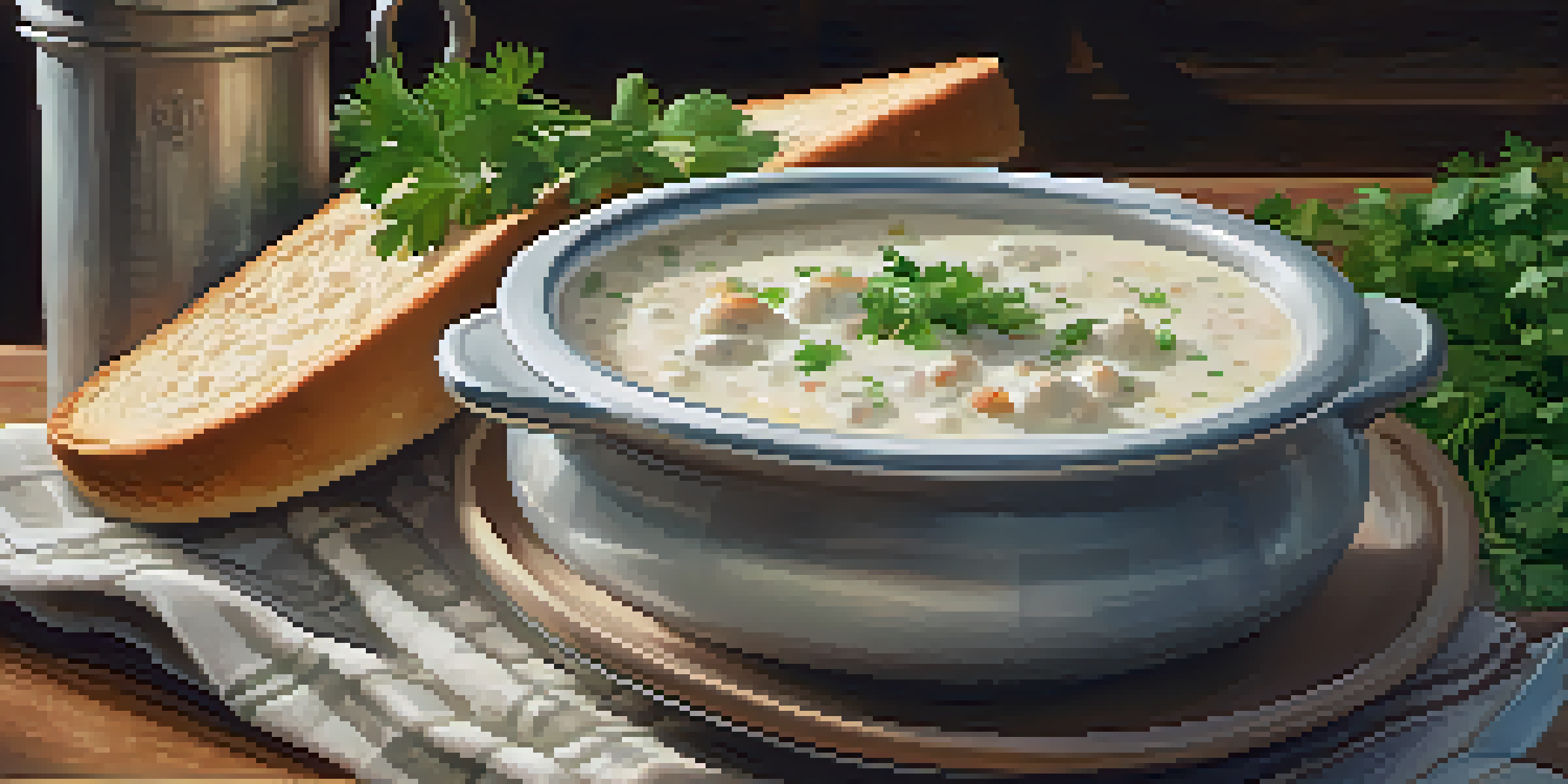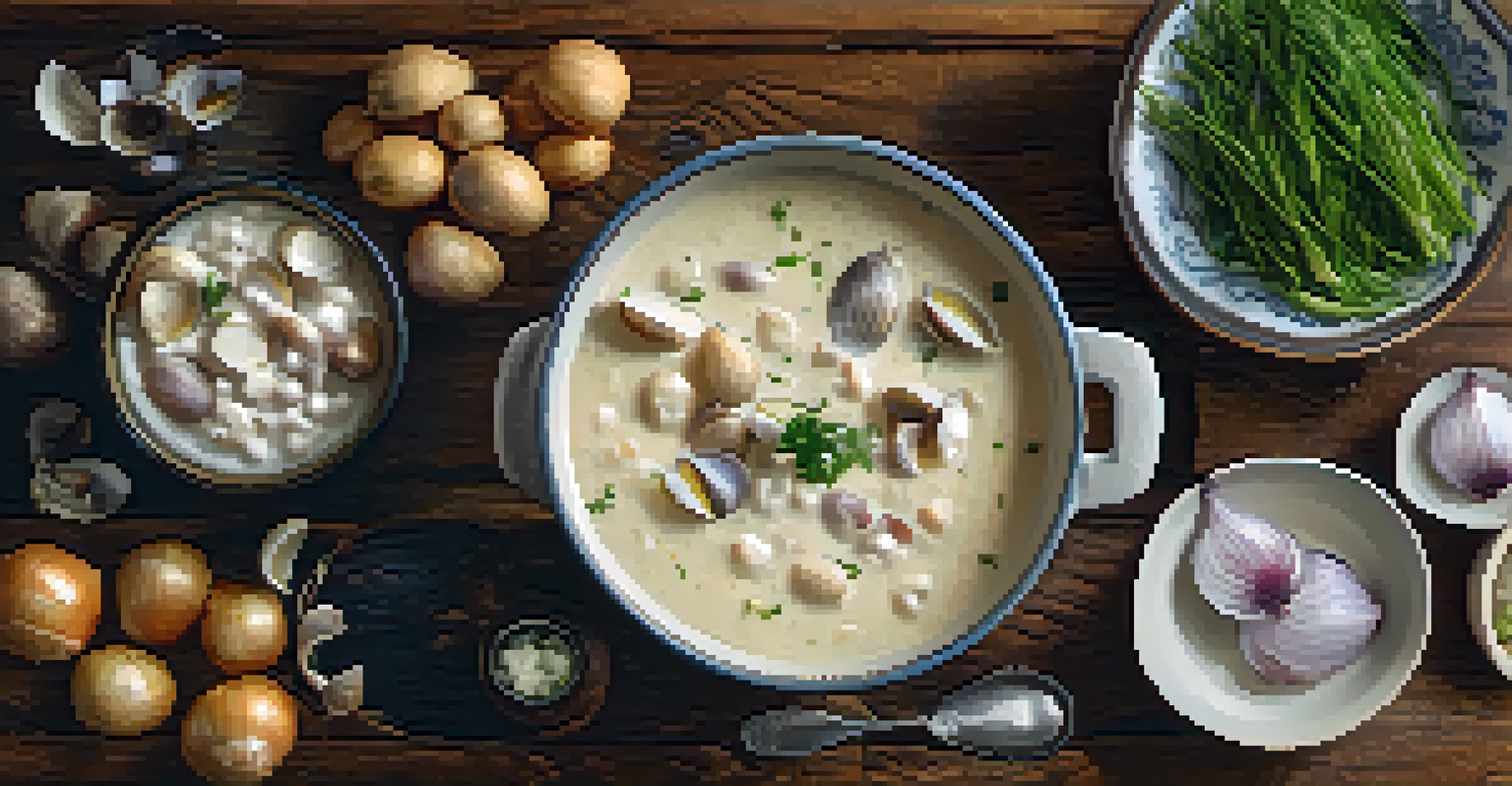The Birthplace of Clam Chowder: Boston's Culinary Icon

The Origins of Clam Chowder in Boston
Clam chowder, a creamy and hearty soup, traces its roots back to the early days of Boston. It is believed that the dish originated from the fishermen who would prepare it using local clams, potatoes, and milk. This culinary creation soon became a staple among Bostonians, reflecting the city's maritime heritage.
Food is our common ground, a universal experience.
The earliest written recipe for clam chowder appeared in the 18th century, showcasing its growing popularity. As Boston evolved into a bustling port city, the chowder gained traction among locals and visitors alike. The use of fresh, locally sourced ingredients has always been a hallmark of this dish, emphasizing the connection between the city and its coastal bounty.
Today, clam chowder is not just a dish but a symbol of Boston's rich culinary history. It's often served in a bread bowl, making it a favorite among tourists and residents. The love for this iconic soup continues to thrive, keeping its legacy alive in Boston's vibrant food scene.
The Ingredients that Make It Special
At the heart of clam chowder are its classic ingredients: clams, potatoes, onions, and cream. Each component plays a vital role in creating the soup's signature flavor and texture. The clams provide a briny richness, while the potatoes add heartiness that makes each bowl satisfying.

Many recipes also incorporate bacon or salt pork, enhancing the chowder's savory depth. The use of heavy cream gives the soup its creamy consistency, making it comforting and indulgent. This combination of ingredients showcases the ingenuity of early Bostonians who utilized local resources to craft a beloved dish.
Clam Chowder's Boston Origins
Clam chowder originated from Boston's fishermen, becoming a staple that reflects the city's maritime heritage.
While there are variations of clam chowder, such as the tomato-based Manhattan version, Boston's clam chowder remains unrivaled in its creamy, rich profile. Each spoonful offers a taste of the ocean, bringing warmth and nostalgia to those who enjoy it. This classic dish continues to adapt while honoring its roots.
Clam Chowder in Boston Restaurants
Boston is home to numerous restaurants that proudly serve their own versions of clam chowder. From iconic establishments like Legal Sea Foods to cozy local diners, each place puts its twist on this classic dish. The competition among chefs to create the best chowder adds to the excitement of dining in the city.
The only thing I like better than talking about food is eating.
Many restaurants highlight their chowder with fresh herbs or unique garnishes, enhancing the presentation and flavor. Visitors often seek out recommendations to find the 'best' clam chowder, making it a delicious adventure. This quest not only satisfies cravings but also showcases Boston's culinary diversity.
In addition to traditional servings, some restaurants even offer chowder fries or chowder tacos, blending classic flavors with contemporary twists. These creative interpretations keep clam chowder relevant in today’s dining scene, appealing to both purists and adventurous eaters. The love for this dish is evident in every bowl served across the city.
The Cultural Significance of Clam Chowder
Clam chowder is more than just a dish; it embodies the spirit and culture of Boston. It represents the city's history, from its fishing roots to its modern culinary scene. Sharing a bowl of chowder is often a communal experience, bringing friends and family together.
Local events, such as chowder festivals and competitions, celebrate this beloved soup, further solidifying its status as a Boston icon. These gatherings allow chefs and home cooks to showcase their skills while fostering a sense of community. The enthusiasm surrounding clam chowder is infectious.
Cultural Significance of Chowder
Clam chowder embodies Boston's spirit, fostering communal experiences and celebrating local traditions.
As Boston continues to grow and evolve, clam chowder remains a cherished tradition. Its presence in local culture highlights the importance of food in creating connections and preserving history. For many, a visit to Boston wouldn’t be complete without savoring this iconic dish.
Clam Chowder: A Seasonal Delight
While clam chowder can be enjoyed year-round, it often takes center stage during the colder months. The rich, creamy flavors provide comfort during chilly Boston winters, making it a popular choice for locals. There's something about a steaming bowl of chowder that just feels right when the temperature drops.
Many restaurants offer seasonal specials, encouraging diners to indulge in chowder as part of their winter dining experience. Additionally, the availability of fresh clams during certain times of the year enhances the quality of the dish. This seasonal approach ensures that each bowl is packed with flavor.
As spring approaches, some eateries begin to incorporate lighter versions of chowder, showcasing the versatility of this classic dish. Regardless of the season, clam chowder remains a beloved staple on menus throughout the city, adapting to the changing culinary landscape while staying true to its roots.
Making Clam Chowder at Home
For those who want to bring a taste of Boston into their kitchens, making clam chowder at home can be a rewarding experience. With just a few key ingredients, anyone can whip up a batch of this comforting soup. Many recipes are straightforward, making it accessible for cooks of all skill levels.
Starting with fresh clams and building the base with sautéed onions and bacon creates a flavorful foundation. Adding potatoes and cream transforms it into a hearty dish that captures the essence of Boston's culinary heritage. The process of simmering the chowder allows the flavors to meld beautifully, resulting in a delightful meal.
Chowder: A Year-Round Favorite
While enjoyed year-round, clam chowder shines during colder months, offering warmth and comfort to locals.
Experimenting with different spices or garnishes can add a personal touch to homemade clam chowder. Whether it's a sprinkle of fresh parsley or a dash of hot sauce, these little enhancements can elevate the dish. Sharing a homemade bowl of chowder with loved ones creates lasting memories and celebrates the spirit of Boston cuisine.
Clam Chowder in Popular Culture
Clam chowder has made its mark not only on dining tables but also in popular culture. It appears in literature, movies, and television shows, often symbolizing comfort and home. This widespread recognition speaks to the dish’s significance in American culinary history.
In films set in Boston, chowder is frequently featured as a beloved local delicacy, showcasing the city's food culture. Characters enjoying a bowl of clam chowder evoke a sense of warmth and belonging, reinforcing its status as a comforting classic. It’s a dish that resonates with both locals and those who visit the city.

Furthermore, clam chowder is often highlighted in food competitions and showcases, celebrating its enduring popularity. These cultural references contribute to the ongoing love affair between clam chowder and the people of Boston. It's a dish that transcends generations, uniting people through its rich flavors and comforting presence.